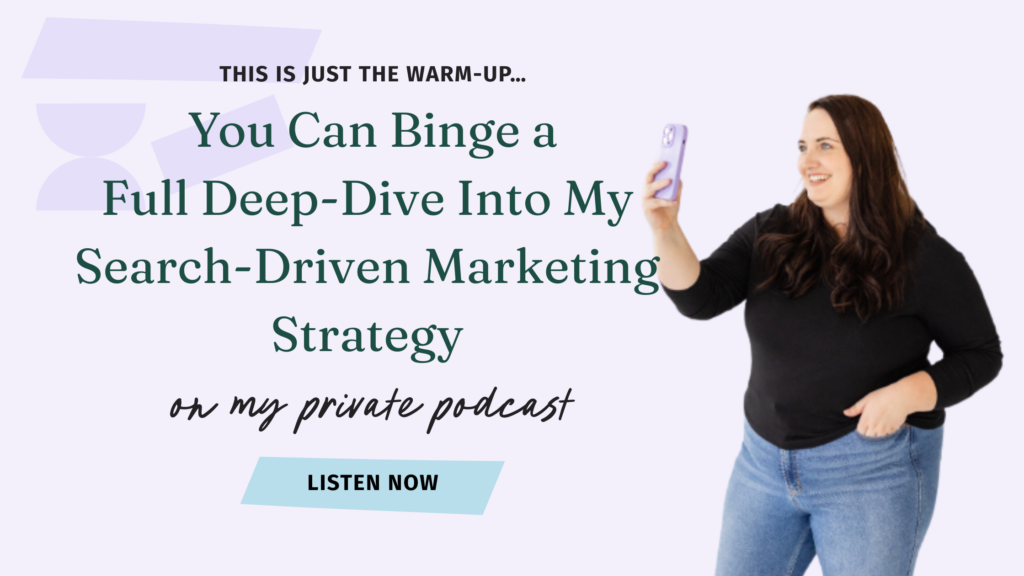Want to know how to write blog posts for your wedding business that actually drives traffic? If you’re a wedding pro, that’s probably the only reason you’re blogging in the first place. You want to showcase your couples and the beautiful weddings you planned, photographed, or designed or maybe you’re sharing inspirational or informational content. Either way, the goal is traffic, right?
Most of the time, we’re blogging for SEO. And there’s nothing more frustrating than putting in the effort only to feel like… nothing’s happening. If that sounds familiar, you’re definitely not alone.
Today, I’m going to share exactly how to write a blog post that brings in traffic for your wedding business.
And in case we haven’t met yet—I’m Kara. I write blog content and manage Pinterest for wedding pros and other service providers. I’ve been doing this for the past five years, starting as a COVID pivot.
I also own a destination wedding planning business that still runs today—though I’m no longer one of the planners, which is kind of fun. So trust me when I say: I’ve been exactly where you are. And honestly, I was shocked when blogging became my number one source of leads.
If you’re feeling a little skeptical, I get it. But stick with me—we’re going to talk about exactly how to make it work.
Table of Contents
1. Start With Keyword Research
Let’s start with part one: keyword research. This is the most important piece—and I know you might be tempted to resist it—but hear me out. One of the biggest issues I see is that we’re getting way too technical with our keywords.
Instead of writing a blog post around a clear, simple topic like “garden wedding ideas,” we go overboard with hyper-specific phrases like “ethereal garden wedding ideas under $5,000.” We’re layering on so much detail that we miss what people are actually searching for.
Couples are typically searching for broad concepts like “classic wedding inspiration.” Meanwhile, we’re out here writing about “monochromatic modern weddings with classic elements.” See the disconnect?
Here’s an example I think everyone can relate to: the term “wedding weekends.” It’s only recently become a common SEO keyword. A few years ago, lots of us wanted to book them, but hardly anyone was searching for them. So it didn’t make sense to write about it back then—until it became something couples were actively Googling.
So, rule number one for blog traffic: write content based around actual keywords people are searching for.
How to Do Keyword Research (Without Going Overboard)
I use SEMrush—it’s a professional-grade tool, and a higher investment. I’d only recommend it if you’re writing 8+ blog posts a month. If you’re writing fewer than that, you’re not likely to see enough ROI.
Here are more beginner-friendly (and budget-friendly) tools:
- Ubersuggest – Free plan available, good starting point.
- Keywords Everywhere – Very affordable browser extension.
- Google Search Auto-Suggest – Just start typing “wedding planner” or “garden wedding,” and see what autocomplete suggests.
- Google Trends – Often overlooked, but super useful.
- Pinterest Trends – Especially helpful for wedding pros; lots of overlap with Google keywords.
When you’re looking at keyword data, focus on:
- Search volume – Even 50 monthly searches can be valuable if it’s highly relevant or location-specific.
- Competition – Aim for low to medium competition.
- Relevance – Is this keyword directly related to your actual service?
Don’t get too caught up in chasing big numbers. A keyword with 50 searches a month that’s highly relevant can be more powerful than one with 10,000 generic searches.
And remember: when you’re trying to write blog posts for your wedding business, you’re likely competing locally, not nationally. That’s a huge advantage.
A Quick Note on Relevance During Keyword Research
If you’re a wedding planner and you don’t offer day-of coordination, don’t write a blog post about putting together the perfect welcome bags. By the time someone’s Googling that, they’ve probably already booked their planner—or decided not to.
Instead, think about writing on:
- “What to look for in a wedding venue”
- “Should you book a venue before hiring a planner?”
- “10 questions to ask your wedding planner”
- “8 of my favorite spring wedding color palettes”
These types of posts can meet couples earlier in their decision-making process—and they’re often great traffic drivers.

2. Consider Buyer Awareness
This ties directly into keyword relevance: understanding where your reader is in their buying journey.
We often assume couples know what we offer—but they may not. For example, if you’re a wedding content creator or a photographer, couples may not understand what services you provide or what’s expected of them. They don’t know what they don’t know.
I see this all the time when I audit websites for blogging and Pinterest. Some contact forms include pre-qualifying questions like “What’s your budget?” or “What venues have you looked at?”—but the couple might not have those answers yet. It’s not that they’re withholding info—they’re just overwhelmed or early in the process.
So, when you’re writing content and structuring your website, think about where your audience is in their planning journey. Some visitors might be ready to book. Others are still gathering ideas and learning what questions to ask. Your content should serve both types.
I always say: your blog should meet people at the “Googling at midnight in a panic” stage. That means having more than just one post. Create a collection of content they can binge. Make it easy for them to go down the rabbit hole.
You also want to give them an easy next step. That could be:
- Signing up for your email list (with a helpful freebie)
- Taking a quiz
- Clicking over to your Instagram
I especially love writing blog posts that lead to Instagram content. It lets them binge more of your work in a really natural way. And honestly, in my own wedding business, I can’t tell you how many times someone has reached out and said, “I stayed up all night reading your blog posts.” That kind of bingeable content builds trust fast.
So yes, traffic is the goal—but you also want to make sure you’re creating content for people at all stages of the journey. Some couples just got engaged yesterday, while others are finally ready to book. Your blog should have something for both.
3. Do “SEO” And Proper Formatting
Now, let’s talk practical SEO and formatting tips for when you write blog posts for your wedding business. These are the ones that will actually make a difference if you want real traffic.
Word Count
Clients ask me about this all the time. For most wedding pros, aim for 800 to 1,500 words per blog post. The days of 200–300 word blurbs above a photo collage? Over. Done.
But that doesn’t mean you should drop giant walls of text either.
Break it up! If you’re using WordPress or Showit, add spacers between sections to make it easier to skim. Because that’s how most people will read—skimming, not word-for-word.
Use Proper Heading Structure
One of the most common SEO mistakes I see is improper heading usage.
Here’s the deal:
- You should only have one H1—your blog post title.
- Use H2 for your main section headings.
- Use H3 for sub-points under each H2.
This matters because search engines use headings to understand your page structure. I see this a lot with Showit websites, where headings are chosen for how they look rather than for their function. But if everything is labeled as an H1, you’re telling Google that every section is equally important—which is not true.
Go back and audit your posts. You’ll likely see what I mean: the last sub-point in a post should not have the same weight as the title.
Add Internal and External Links
A big mistake I often see is blog posts with no links at all. That’s a missed opportunity.
At minimum, link to:
- Other blog posts
- Your services page
- Your contact page
For bonus SEO points, add a few external links as well. Google loves seeing that you’re referencing other reputable sources—it positions you as a valuable resource.
That said, I like to keep people in my world. So if I’m linking externally, I try to choose links that keep them engaged with my brand or are contextually helpful without sending them too far off. So maybe you link to a feature where you were published, your Instagram, your email opt-in, or your Pinterest for more inspiration. Use high-authority links when linking externally—don’t just link to your sister’s Etsy shop. Think about where you want that reader to go next and how to keep warming them up.
Optimize Your Images
Images are a huge part of SEO, even though they don’t get talked about enough.
Every image you upload should be:
- Renamed (use descriptive filenames before uploading)
- Resized (so the file size isn’t massive and slowing your site)
- Tagged with alt text (a simple description of the image, ideally helpful for accessibility and SEO)
As a general rule:
- Include your main keyword in image alt text maybe 10–20% of the time.
- If you have only 3–5 images: maybe 40% of them can include the keyword.
- If you have 100 images: scale back to 10%.
Keep it natural. Use the keyword when it makes sense—don’t force it.
Using Your Keyword and Plugins
Here are a few simple but powerful on-page SEO practices:
Include your keyword in:
- The title
- The first 100 words
- The URL
- The meta title and meta description
If you’re on WordPress, install an SEO plugin:
- Yoast SEO (popular, widely used)
- Rank Math (my personal favorite; also free)
These plugins will scan your post and flag what’s missing. Are they perfect? No. Sometimes they’ll give you a green light too easily. But they’re still a fantastic starting point. They’ll alert you if your keyword density is too low—like 0.001%—when ideally, you should be hitting around 1%. So for a 1,000-word blog post, aim to include your keyword about 10 times.

4. Track Your Blog’s Performance (Boring but Important)
Here’s the unsexy part—but it’s so important: track your results.
You’ve invested time into creating your blog posts—so don’t let them gather dust. It’s often easier and more effective to update past blogs than to keep writing new ones from scratch.
Sign up for:
- Google Search Console
- Bing Webmaster Tools
Once you publish a blog post, submit it to both platforms. Start with Google, then set up Bing—it can sync through your Google Analytics, so it’s fast.
Why Bing? Because Bing powers ChatGPT’s search. If you’re thinking about the future of AI and SEO, it’s worth having your content show up both on Google and wherever AI models are pulling from.
These platforms will show you:
- How many times your blog post appeared in search results
- How many clicks it got
With that data, you can make smart decisions instead of relying on vibes. And yes, blogging can feel like a slow burn. But when you see the small wins, you’ll start to understand how they build momentum.
Final Thoughts and Recap
If you want more help, I’ve got a free guide on writing blog posts that actually convert—so once you get the traffic, you know what to do with it. Or, if you’re ready to hand this off, I’d love to work together. Visit thekarareport.com/services to learn how we can make it happen.
How to Write Posts For Your Wedding Business That Drive Traffic
- Start with keyword research
- Align content with buyer awareness stages
- Use smart formatting and SEO best practices
- Track your results—and double down on what’s working
Thanks so much for watching, and I’ll see you in the next video!